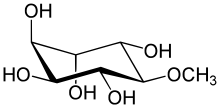pinitol
English

Structure diagram of D-pinitol
Noun
pinitol (countable and uncountable, plural pinitols)
- (organic chemistry) A cyclitol with antidiabetic activity, first identified in the sugar pine (Pinus lambertiana).
- 2001, Ryszard J. Górecki, 5: Seed Physiology and Biochemistry, C. L. Hedley (editor), Carbohydrates in Grain Legume Seeds: Improving Nutritional Quality and Agronomic Characteristics, CABI Publishing, page 126,
- Galactosylononitol and galactosyl pinitol A could also substitute for galactinol in the synthesis of stachyose from raffinose (Peterbaur and Richter, 1998; Hoch et al, 1999; Fig. 5.2, equations 10 and 11).
- 2007, Tomas Hudlicky, Josephine W. Reed, The Way of Synthesis: Evolution of Design and Methods for Natural Products, Wiley, page 149,
- The reader can once more appreciate the lack of suitable language to describe these design principles; the thought process that led to the enantiodivergent synthesis of pinitols was far less arduous than the attempts to verbalize it.
- 2014, T. K. Lim, Edible Medicinal and Non Medicinal Plants, Volume 8: Flowers, Springer, page 492,
- The use of B. spectabilis leaves as an antidiabetic led to the isolation of its hypoglycaemic principle, pinitol, from the leaves (Narayanan et al. 1987). Pinitol was determined to be a methyl ester of chiro-inositol and elucidated as 3-O-methyl1,2,4-cis-3,5,6-trans-hexahydroxycyclohexanol.
- 2001, Ryszard J. Górecki, 5: Seed Physiology and Biochemistry, C. L. Hedley (editor), Carbohydrates in Grain Legume Seeds: Improving Nutritional Quality and Agronomic Characteristics, CABI Publishing, page 126,
Derived terms
- D-pinitol
Related terms
- D-pinitol dehydrogenase
Translations
cyclitol with antidiabetic properties
Further reading


This article is issued from
Wiktionary.
The text is licensed under Creative
Commons - Attribution - Sharealike.
Additional terms may apply for the media files.